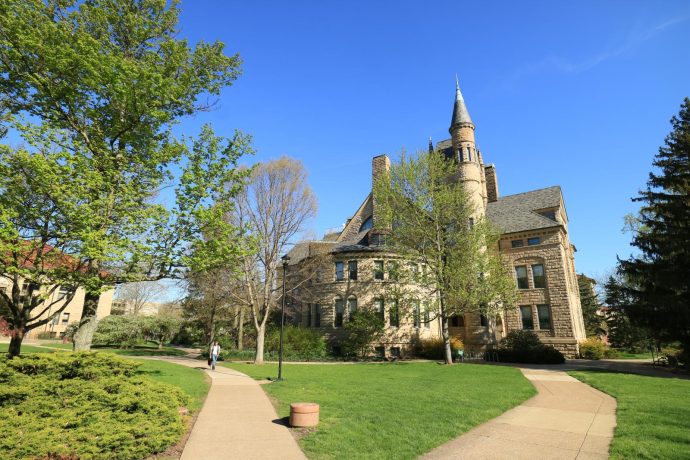- Start with pre-existing faculty interests and strengths. Survey those strengths and the strengths of your community: What do you have that works to your advantage?
- Don’t reinvent the wheel. Look at other models and consider how their core essence might work at your institution.
- Don’t be afraid to try something new just because it might not succeed. Programs can be modified in response to feedback after two or three years.
- Be prepared to spend significant energy getting the word out about the program. People won’t know you’re there unless you tell them!
Oberlin College’s Public Humanities Integrative Concentration

The Public Humanities Integrative Concentration at ACLS Associate Member Oberlin College allows students in any discipline to integrate the public humanities into their coursework. Unlike a major or a minor, the concentration is designed to be both interdisciplinary and experiential. Students who successfully complete it take with them a cumulative learning portfolio.
Oberlin offers a range of integrative concentrations in such areas as Business, Data Science, Peace and Conflict Studies, Food Studies, and Arts Administration where Oberlin has clear strengths and students have demonstrated interest, but which have no clearly associated department or discipline. An integrative concentration gives those areas of study visibility and provides students with clear curricular pathways without requiring many additional resources. For students, the concentrations connect them to experiential education in a way that is more intentional and rigorous than free-floating independent studies or internships.
Since 2021-22, the Public Humanities Integrative Concentration has provided a home for pre-existing faculty interests across a number of departments. Many faculty members were already engaged in public-facing work in museums, foundations, oral history projects, and community engagement more broadly. Students are encouraged to begin with the required “Introduction to Public Humanities” course, which provides both hands-on experience and a theoretical grounding for the rest of the concentration. This course is team-taught by a faculty member of record and a series of visiting faculty, each of whom take one to two weeks to talk about what public humanities work looks like for their discipline.
In addition to the introductory course, students must complete several other required courses pulled from across the humanities and humanistic social science disciplines offered at Oberlin:
- One Community-Based Learning (CBL) course, such as Latinx Oral Histories; Ethnomusicology as Activism; Practicum in Environmental Communication; and the Writers in the Schools Practicum.
- One Theory and Methods course, such as Shakespearean Comedy and Social Justice; Museums: A Social, Political, and Institutional History; and Archives Reimagined.
- Three Public Humanities Electives, such as Arts Management; Music as Social Life; Saints, Sinners, and Other Cursed Women; Religion and Violence; and Serving the Public: Labor & Place in Cafes, Bars, and Restaurants.
As of this writing, students have over eighty courses to choose from in fulfilling their requirements. Students must take courses from multiple departments, though Oberlin does allow them to count courses toward both the concentration and a major or minor. Indeed, after the concentration was established, a number of students were able to retroactively enroll and complete it, based on courses they had already taken.
In addition to coursework, students must demonstrate two skill competencies from a list of skills and practices that are often employed in public humanities work. This is a feature unique to the public humanities concentration; most other concentrations do not have a list of required skills. The faculty who created the concentration felt strongly that students should have a sense of both what they can do in the public humanities and what kinds of skills were associated with the field. These competencies include:
- Communicating with Diverse Publics/Public Speaking
- Grant Writing
- Project Management
- Sonic Storytelling (Podcasting, etc.)
- Translation: Translating Humanities Scholarship for a Public Audience
- Video Storytelling
Finally, students are required to complete a substantial experiential learning component. This experiential learning opportunity must be full time for at least four weeks; Oberlin’s experimental Winter Term provides an obvious opportunity for such an experience. Students are encouraged to find internships through the campus career center, but there are also a number of on-campus opportunities that students can pursue, such as the campus art museum, archives, and library, as well as the History Design Lab. Affiliated faculty are also encouraged to design internship or practicum opportunities for students.
Oberlin’s public humanities integrative concentration demonstrates the value of fostering connections, whether those are across programs and departments or between the university and the world beyond. Those connections are crucial for building educational experiences that are interdisciplinary and experiential and give students the skills and knowledge they need for success.

